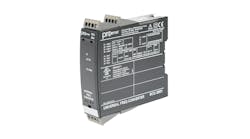Optimizing automation: Top conveyor tech tips for integrators in distribution and processing
As companies increasingly look to bring new conveyor technology into existing processes and facilities, the role of the integrator has never been more important. The options on the market seem limitless when it comes to choosing the right conveyor system. Integrators play a crucial role in helping companies not only select the most cost-effective conveyor, but one that is easy to install — and easy to maintain.
Based on years of experience in this rapidly changing field of packaging and material handling, Regal Rexnord identified a few key areas in which integrators can sharpen their knowledge and skills to further improve relationships with conveyor suppliers. Doing so will ultimately create the best possible outcome for their customers.
1. Embrace automation and early engagement
- Integration with existing systems: Ensure that the new technology can seamlessly integrate with existing processing and digital technologies, like conveyor subsystems and warehouse management systems (WMSs). Automation should enhance throughput and reduce costs without requiring a complete overhaul.
- Robotics and automation: The integration of robots into conveyor systems is not just about filling gaps in the workforce but enhancing it. Robots can perform repetitive tasks at higher speeds, increasing production and allowing human workers to focus on high-value activities.
- Early engagement: Early collaboration is crucial in aligning the project goals with technological capabilities, especially given how lengthy some sales cycles can be. For example, the ModSort Divert & Transfer Module system integrated into one of DISH Network’s distribution warehouses in North Carolina had a total sales cycle of five years. By getting Regal Rexnord involved early, integrators were crucial to creating a successful system that ultimately lowered annual labor costs by $90,000 for the customer.
2. Understand the technology ... and the TCO
- Evaluate the long-term costs associated with new automation equipment — not just the purchase price. This includes maintenance, energy costs, programming requirements, and potential downtime. When implementing these systems, it’s also important to consider how you will measure the success of automating a specific process. Ensure that these strategies align with business goals and determine KPIs to understand how the benefits of the automated process justify the cost. Consider each of these factors as you work with your customer to integrate a new system.
- Familiarize yourself with the latest technologies such as autonomous mobile robots (AMRs), guidance control systems, scanners, cameras, vehicle controllers, navigation sensors and zero tangent curve systems. You will need to understand how these technologies work and integrate into current conveyor systems. Understand the products customers are moving and their production speed to prioritize applications based on customer needs and feasibility.
As an integrator, do you understand the basics of conveying robotics? Here’s a quick overview of the common approaches, each uniquely suited for your customer’s specific operational needs.
Conveyor pusher arms: Can be driven with a compressed air pneumatic air system or with an electrical actuator.
Conveyor paddle arms: A large, cantilevered arm that can generate a lot of torque on that swivel point.
Pop-up belt diverters: Electrically driven, these belts pop up and divert cartons at a 90-degree angle.
Conveyor swivel wheels: A swivel wheel diverts to different spurs and is electrically actuated.
Omni-directional roller ball diverters: Free-spinning spheres are embedded into the conveyor belt on one-inch pitches enabling cartons and polybags to be diverted at any angle desired.
Autonomous storage and retrieval systems (AS/RS): Automated guide vehicles that are like spiders combing a huge structure. These structures tend to be quite large and relatively expensive, but they can store a lot of products within them.
Autonomous mobile robots (AMRs): Robots that guide themselves either by reading QR codes spaced out on a grid on the floor or are guided by a network operator with LiDAR equipped on the vehicles to avoid obstacles.
3. Energy efficiency, safety and market adaptation
- Energy-efficient solutions: Look for systems that prioritize energy efficiency, which can significantly reduce operational costs over time.
- Safety and intelligence: Automation solutions should not only be safe to operate but also smart enough to adapt to different operational needs and enhance overall workplace safety.
- Adapting to market needs: Integrators help in adapting technologies to meet the specific needs of different markets, as seen in their role at industry trade shows such as Pack Expo. Integrators play a crucial role in implementing new technologies in setups like Sierra Nevada Brewing Co., where Regal Rexnord’s System Plast NG Evo Chain “dry run” conveyor technology reduces or eliminates lubrication. In addition to reducing water usage, dry run conveyors improve safety conditions, lower costs, and improve conveyor performance.
4. Market trends, demographic challenges and customer engagement
- Demographic shifts: Automation can help address labor shortages and demographic changes affecting the workforce by reducing the physical strain on workers and filling labor gaps.
- Retailers’ in-house engineering: Be aware that large retailers are increasingly developing their own material handling specifications, which could influence market dynamics and customer expectations.
- Customer engagement: Testimonials and success stories involving integrators are vital in demonstrating the effectiveness of new technologies to potential customers. If integrators can’t create their own marketing materials that illustrate customer engagement, they should look for strategic partners who can help tell that story for them. Regal Rexnord has ample videos and stories that show how strong integrator relationships can improve customer outcomes.
5. Preparing for integration and long sales cycles
Assess operational needs: Clearly define what you need from an automation solution in terms of adaptability, capacity, and specific operational challenges. Without fully understanding the needs of the customer – including the current manual operations – finding the best comprehensive solution for their applications will be challenging.
Vendor selection: Choose a vendor that not only provides the technology but also offers comprehensive support, is financially stable, and understands the broader industry challenges and how to solve them.
Understanding sales cycles: Understand that there can be long sales cycles when it comes to an integration project. The process can span several years before fruition due to the number of decision makers involved and the capital funds available.
6. Stay informed about industry events and build lasting relationships
- Industry engagement: Participate in association groups, trade shows, and conferences to stay updated on the latest innovations and to network with technology providers.
- Building relationships: The DISH Network customer success mentioned earlier in this article began with a meeting between a Regal Rexnord engineer and an integrator at the MODEX trade show in 2018. The fact that a chance encounter led to such a significant project emphasizes the importance of building and maintaining relationships within the industry.
By keeping these considerations and key points in mind, integrators can make informed decisions that align with their customers’ operational goals and the evolving landscape of conveyor technology integration.


